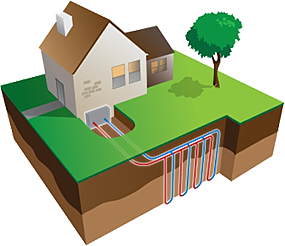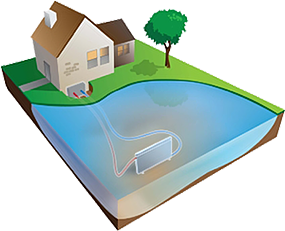Geothermal Heat Pump Loop Configurations
Loop Piping
High-density polyethylene: In most cases the loop piping is made of flexible, high-density polyethylene that is warranted for 50 years and has a life expectancy of 200 years. Its flexibility and lack of "coil memory" also make it easier to install than the polybutylene used just a few years ago. In residential installations, it's usually 3/4 in. in diameter and is joined with heat-sealed (thermal-fusion) fittings.
Copper: In a direct exchange (DX) system refrigerant circulates through highly conductive copper earth loops that are inserted into bore-holes of 50 or 100 foot depth, then embedded in a protective thermal grout that enables direct transfer of energy with the earth. This simplicity allows the system to reach high efficiencies while using a relatively shorter and smaller set of buried tubing, reducing installation cost.
Ground Loops
When it comes to ground loops, there are two general system types–open loop and closed loop. Closed-loop systems are more common and can be trenched or bored underground horizontally or installed vertically like water wells. If you live next to a private lake, piping can even be laid underwater on the lake bed. You'd need at least 8 ft. of water over the pipe year-round but, if this option is available, it's far less costly than an underground loop.
The second option, an open-loop installation, is not as popular as it used to be. In this case, a dedicated well with a submersible pump serves as the source of water delivered to the heat pump. Once the water is cycled through the system, it's returned to the aquifer–typically through a second well drilled specifically for this purpose, or to a nearby stream or lake. While these systems are quite efficient, they tend to be more expensive. Water wells are costly and water quality can be a problem. You'd also have the added cost of running the submersible pump, typically $150 to $220 per year.
 Horizontal Loops
Horizontal Loops
The most common installation is a horizontal loop. In this situation, an access pit is dug near the house, so the piping loop can be brought through the foundation wall and connected to the indoor compressor unit. From this pit, several piping loops are bored or trenched at least 5 ft. deep.
On average, a horizontal system requires 220 ft. of piping for every ton of compressor load (12,000 BTUs of heat). A newer 2000- to 2400-sq.-ft. home will require 3 tons of capacity and roughly 660 ft. of piping loop. Two pipes can be installed in each narrow trench or bore–one out and one return–so that's 330 ft. of trench. If a backhoe is used and a 3-ft.-wide trench is dug, six pipes can be laid in one trench, allowing a shorter trench.
Horizontal systems have always required lots of unencumbered space, but two recent developments have shrunk the lot-size requirements a little. First, new boring technology allows the operator to accurately steer a 5-in. boring machine under and around common obstructions. Starting from a header pit near the house, the machine can dive under outbuildings, trees and septic systems, and come up 100 ft. away. When finished, two pipes, fused with a "U" fitting on the far end, are pulled through most of the bore. The tail end of the bore hole is then backfilled or packed with a dense grouting material such as bentonite clay.
Slinky Loops
The other new twist has more to do with ingenuity than equipment. Instead of laying the pipe lengthwise in the bottom of a long trench, it is coiled in 2-ft.- to 3-ft.-dia. loops like a large Slinky toy. The coils are then laid down and covered with soil. This "Slinky" method greatly increases surface exposure and substantially reduces the amount of trenching needed. With these two innovations, a horizontal system can often be installed on a lot as small as 1/4 acre.
 Vertical Loops
Vertical Loops
When a property won't accommodate even this much trenching or boring a vertical, closed-loop system is the next best option. In this case, a well driller typically drills several holes without casings 150 ft. to 200 ft. deep. The contractor then drops two pipes joined with a U fitting at the bottom into each hole and joins all pipes from all holes in a common pit 5 ft. to 6 ft. deep. Then the contractor runs a feed line and return line through the foundation wall and connects them to the compressor unit. Before filling the pit, each bore hole is grouted to meet state and local codes.
Vertical, closed-loop systems are actually more efficient, but require more piping–typically 300 ft. per ton–is required.
 Pond or Lake Closed Loops
Pond or Lake Closed Loops
This type of loop design may be the most economical when a home is near a body of water such as a pond or lake. Fluid circulates underwater through polyethylene piping in a closed system, just as it does through ground loops. The pipes may be coiled in a slinky shape to fit more of it into a given amount of space. Since it is a closed system, it results in no adverse impacts on the aquatic system.
Geothermal Heat Pump Loop Configurations copyright 2011 Digtheheat.com
